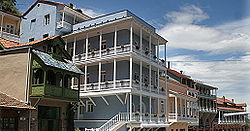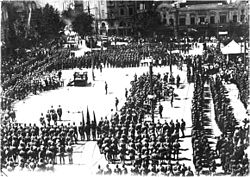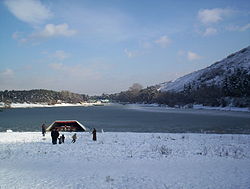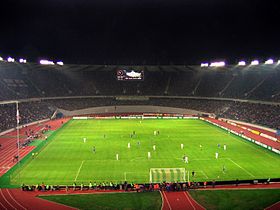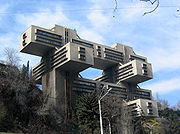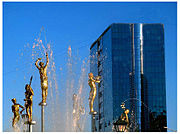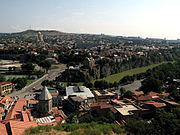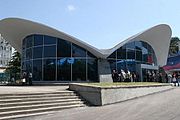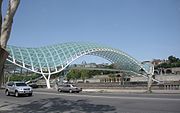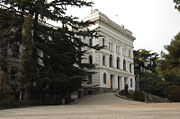- Tbilisi
-
Tbilisi
თბილისიPanoramic view of Tbilisi 
Flag
SealLocation of Tbilisi in Georgia Coordinates: 41°43′0″N 44°47′0″E / 41.716667°N 44.783333°E Country Georgia Established c. 479 A.D Government – Mayor Giorgi (Gigi) Ugulava Area – City 726 km2 (280.3 sq mi) Highest elevation 770 m (2,526 ft) Lowest elevation 380 m (1,247 ft) Population (2010) – City 1,152,500 – Density 1,587.5/km2 (4,111.5/sq mi) – Metro 1,485,293 Time zone Georgian Time (UTC+4) Area code(s) +995 32 Website www.tbilisi.gov.ge Tbilisi (Georgian: თბილისი [tb̥ ilisi] (
 listen)) is the capital and the largest city of Georgia, lying on the banks of the Mt'k'vari (Kura) River. The name is derived from an early Georgian form T'pilisi (ტფილისი) and it was officially known as Tiflis until 1936.[1] The city covers an area of 726 km2 (280 sq mi) and has 1,480,000 inhabitants.
listen)) is the capital and the largest city of Georgia, lying on the banks of the Mt'k'vari (Kura) River. The name is derived from an early Georgian form T'pilisi (ტფილისი) and it was officially known as Tiflis until 1936.[1] The city covers an area of 726 km2 (280 sq mi) and has 1,480,000 inhabitants.Founded in the 5th century by Vakhtang Gorgasali, the Georgian King of Iberia, and made into a capital in the 6th century, Tbilisi is a significant industrial, social, and cultural centre. The city is also emerging as an important transit route for global energy and trade projects. Located strategically at the crossroads between Europe and Asia and lying along the historic Silk Road routes, Tbilisi has often been a point of contention between various rival powers and empires. The history of the city can be seen by its architecture, where the Haussmannized Rustaveli Avenue and downtown are blended with the narrower streets of the medieval Narikala district.
The demographics of the city are diverse and historically it has been home to peoples from diverse cultures, religions and ethnicities. Despite being overwhelmingly Orthodox Christian, Tbilisi is one of the few places in the world (Sarajevo and Paramaribo being others) where a synagogue and a mosque are located next to each other, in the ancient Bath district several hundred metres from the Metekhi Church. In recent times, Tbilisi has become known for the peaceful Rose Revolution, which took place around Freedom Square and nearby locations after the contested parliamentary elections of 2003 led to the resignation of the Georgian President Eduard Shevardnadze.
Tbilisi has one international airport. Notable tourist destinations include the Holy Trinity Cathedral of Tbilisi, Freedom Square, Sioni Cathedral, Metekhi, Narikala, Rustaveli Avenue, Tbilisi Opera and Ballet Theatre, Anchiskhati Basilica, Mtatsminda Pantheon (Holy Mountain), Kashveti Church along with the National and Historic Museums of Georgia and a number of art galleries. Tbilisi is the home of famous artists. The city life was immortalized in their art by Niko Pirosmani and Lado Gudiashvili.
Contents
History
Main article: History of TbilisiEarly history
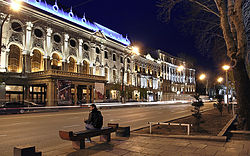 Night on Rustaveli Avenue, Tbilisi
Night on Rustaveli Avenue, Tbilisi
According to an old legend, the present-day territory of Tbilisi was covered by forests as late as 458. One widely accepted variant of the legend of Tbilisi's founding states that King Vakhtang I Gorgasali of Georgia went hunting in the heavily wooded region with a falcon (sometimes the falcon is replaced with either a hawk or other small birds of prey in the legend). The King's falcon allegedly caught or injured a pheasant during the hunt, after which both birds fell into a nearby hot spring and died from burns. King Vakhtang became so impressed with the hot springs that he decided to cut down the forest and build a city on the location. The name Tbilisi derives from the Old Georgian word "Tpili" (თბილი), meaning warm. The name 'Tbili' or 'Tbilisi' ('warm location') was therefore given to the city because of the area's numerous sulphuric hot springs that came out of the ground.
Archaeological studies of the region have revealed that the territory of Tbilisi was settled by humans as early as the 4th millennium BCE. The earliest actual (recorded) accounts of settlement of the location come from the second half of the 4th century CE, when a fortress was built during King Varaz-Bakur's reign. Towards the end of the 4th century the fortress fell into the hands of the Persians after which the location fell back into the hands of the Kings of Kartli (Georgia) by the middle of the 5th century. King Vakhtang I Gorgasali (reigned in the middle and latter part of the 5th century), who is largely credited for founding Tbilisi, was actually responsible for reviving and building up the city and not founding it. The present-day location of the area which Gorgasali seems to have built up is spread out around the Metekhi cliff and the latter-day Abanotubani neighbourhood.
 View of Tbilisi as per French traveller Jean Chardin, 1671
View of Tbilisi as per French traveller Jean Chardin, 1671
Capital
King Dachi I Ujarmeli, who was the successor of Vakhtang I Gorgasali, moved the capital from Mtskheta to Tbilisi according to the will left by his father. It must be mentioned that Tbilisi was not the capital of a unified Georgian state at that time (therefore did not include the territory of Colchis) and was only the capital of Eastern Georgia/Iberia. During his reign, King Dachi I was also responsible for finishing the construction of the fortress wall that lined the city's new boundaries. Beginning from the 6th century, Tbilisi started to grow at a steady pace due to the region's favourable and strategic location which placed the city along important trade and travel routes between Europe and Asia.
Foreign domination
Tbilisi's favourable and strategic location did not necessarily bode well for its existence as Eastern Georgia's/Iberia's capital. Located strategically in the heart of the Caucasus between Europe and Asia, Tbilisi became an object of rivalry between the region's various powers such as Persia, the Byzantine Empire, Arabia and the Seljuk Turks. The cultural development of the city was therefore heavily dependent on who ruled the city at various times. Even though Tbilisi (and Eastern Georgia in general) was able to maintain a certain degree of autonomy from its conquerors, the foreign domination of the city began in the latter half of the 6th century and lasted well into the 10th century.
From 570–580, the Persians took over Tbilisi and ruled it for about a decade. In the year 627, Tbilisi was sacked by the Byzantine/Khazar armies and later, in 736-738, Arab armies entered the town under Marwan II Ibn-Muhammad. After this point, the Arabs established an emirate centered in Tbilisi. The Arab domination brought a certain order to the region and introduced a more formal/modernized judicial system into Georgia. In 764, Tbilisi, still under Arab control was once again sacked by the Khazars. In 853, the armies of Arab leader Bugha Al-Turki (Bugha the Turk) invaded Tbilisi in order to enforce its return to Abbasid allegiance. The Arab domination of Tbilisi continued until about 1050. In 1068, the city was once again sacked, only this time by the Seljuk Turks under Sultan Alp Arslan.
Capital of a unified Georgian state
In 1122, after heavy fighting with the Seljuks that involved at least 60,000 Georgians and up to 300,000 Turks, the troops of the King of Georgia David the Builder entered Tbilisi. After the battles for Tbilisi concluded, David moved his residence from Kutaisi (Western Georgia) to Tbilisi, making it the capital of a unified Georgian State. From 12-13th centuries, Tbilisi became a dominant regional power with a thriving economy (with well-developed trade and skilled labour) and a well-established social system/structure. By the end of the 12th century, the population of Tbilisi had reached 100,000. The city also became an important literary and a cultural center not only for Georgia but for the larger civilized world as well. During Queen Tamar's reign, Shota Rustaveli worked in Tbilisi while writing his legendary epic poem, The Knight in the Panther's Skin. This period is often referred to as "Georgia's Golden Age"[2] or the Georgian Renaissance.[3]
Mongol domination and the following period of instability
Tbilisi's "Golden Age" did not last for more than a century. In 1226 Tbilisi was captured by the refugee Khwarezmian Empire Khwarezmian Shah Mingburnu and its defences severely devastated and prone to Mongol armies. In 1236, after suffering crushing defeats to the Mongols, Georgia came under Mongol domination. The nation itself maintained a form of semi-independence and did not lose its statehood, but Tbilisi was strongly influenced by the Mongols for the next century both politically and culturally. In the 1320s, the Mongols were forcefully expelled from Georgia and Tbilisi became the capital of an independent Georgian state once again. An outbreak of the plague struck the city in 1366.
From the late 14th until the end of the 18th century, Tbilisi came under the rule of various foreign invaders once again and on several occasions was completely burnt to the ground. In 1386, Tbilisi was invaded by the armies of Tamerlane (Timur). In 1444, the city was invaded and destroyed by Jahan Shah (the Shah of the town of Tabriz in Persia). From 1477 to 1478 the city was held by the Ak Koyunlu tribesmen of Uzun Hassan. In 1522, Tbilisi came under Persian control but was later freed in 1524 by King David X of Georgia. During this period, many parts of Tbilisi were reconstructed and rebuilt. In the 17th and 18th centuries, Tbilisi once again became the object of rivalry only this time between the Ottoman Turks and Persia. King Erekle II of Georgia tried on several occasions, successfully, to free Tbilisi from Persian rule but in the end Tbilisi was burnt to the ground in 1795 by Shah Agha-Mohammad Khan. At this point, sensing that Georgia could not hold up against Persia alone, Erekle sought the help of Russia.
Russian control
In 1801, after the Georgian kingdom of Kartl-Kakheti joined the Russian Empire, Tbilisi became the center of the Tbilisi Governorate (Gubernia). From the beginning of the 19th century Tbilisi started to grow economically and politically. New buildings mainly of European style were erected throughout the town. New roads and railroads were built to connect Tbilisi to other important cities in Russia and other parts of the Transcaucasus (locally) such as Batumi, Poti, Baku, and Yerevan. By the 1850s Tbilisi once again emerged as a major trade and a cultural center. The likes of Ilia Chavchavadze, Akaki Tsereteli, Iakob Gogebashvili, Aleksandr Griboyedov and many other statesmen, poets, and artists all found their home in Tbilisi.
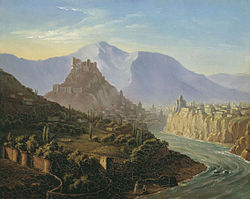 Mikhail Lermontov, Tiflis, 1837.
Mikhail Lermontov, Tiflis, 1837.
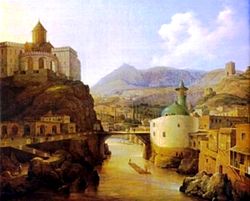 Metekhi cliff and the surroundings as depicted by N.G. Chernetsov, 1839.
Metekhi cliff and the surroundings as depicted by N.G. Chernetsov, 1839.
The city was visited on numerous occasions by and was the object of affection of Alexander Pushkin, Leo Tolstoy, Mikhail Lermontov, the Romanov Family and others. The Romanov Family established their residence (in Transcaucasia) on Golovin Street (Present-day Rustaveli Avenue).
Throughout the century, the political, economic and cultural role of Tbilisi with its ethnic, confessional and cultural diversity was significant not only for Georgia but for the whole Caucasus. Hence, Tbilisi took on a different look. It acquired different architectural monuments and the attributes of an international city, as well as its own urban folklore and language, and the specific Tbilisuri (literally, belonging to Tbilisi) culture. In 1801, Tbilisi had 20,000 inhabitants: 74.3% Armenian, 21.5% Georgian. By 1897, there were 159,000 inhabitants: 38% Armenian, 26.3% Georgian and 24.7% Russian.[4]
Independence
After the Russian Revolution of 1917, the city served as a location of the Transcaucasus interim government which established, in the spring of 1918, the short-lived independent Transcaucasian Federation with the capital in Tbilisi. It was here, in the former Caucasus Vice royal Palace, where the independence of three Transcaucasian nations – Georgia, Armenia and Azerbaijan – was declared on May 26 to 28 1918. After this, Tbilisi functioned as the capital of the Democratic Republic of Georgia until 25 February 1921. From 1918 to 1919 the city was also consecutively home to a German and British military headquarters.
Under the national government, Tbilisi turned into the first Caucasian University City after the Tbilisi State University was founded in 1918, a long-time dream of the Georgians banned by the Imperial Russian authorities for several decades.[5] On 25 February 1921, the Bolshevist Russian 11th Red Army invaded [6][7] Tbilisi after bitter fighting at the outskirts of the city and declared Soviet rule.
Communist government
In 1921, the Democratic Republic of Georgia was occupied by the Soviet Bolshevik forces from Russia, and until 1991 Tbilisi functioned first as the capital city of the Transcaucasian SFSR (which included Armenia, Azerbaijan, and Georgia), and later as the capital of the Georgian Soviet Socialist Republic. During the Soviet rule, Tbilisi's population grew significantly, the city became more industrialised and came to be an important political, social, and cultural centre of the Soviet Union. In 1980 the city housed the first state-sanctioned rock festival in the USSR.
Tbilisi witnessed mass anti-Russian demonstrations during 1956 in the March 9 Massacre, in protest against the anti-Stalin policies of Nikita Khrushchev. Peaceful protests occurred in 1978, and in 1989 the April 9 tragedy was a peaceful protest that turned violent.
After the break-up of the Soviet Union
Since the break-up of the Soviet Union, Tbilisi has experienced periods of significant instability and turmoil. After a brief civil war, which the city endured for two weeks from December 1991 to January 1992 (when pro-Gamsakhurdia and Opposition forces clashed with each other), Tbilisi became the scene of frequent armed confrontations between various mafia clans and illegal business entrepreneurs. Even during the Shevardnadze Era (1993–2003), crime and corruption became rampant at most levels of society. Many segments of society became impoverished because of unemployment caused by the crumbling economy. Average citizens of Tbilisi started to become increasingly disillusioned with the existing quality of life in the city (and in the nation in general). Mass protests took place in November 2003 after falsified parliamentary elections forced more than 100,000 people into the streets and concluded with the Rose Revolution. Since 2003, Tbilisi has experienced considerably more stability with decreasing crime rates, an improved economy and a real estate boom.[8] During the 2008 South Ossetia war the Tbilisi area received multiple Russian air attacks.
After the war, several large-scale projects were started, including a streetcar system,[9] a railway bypass and a relocation of the central station[10] and new urban highways.[11]
Politics and administration
See also: List of mayors of TbilisiThe status of Tbilisi, as the nation's capital, is defined by the Article 10 in the Constitution of Georgia (1995) and the Law on Georgia's Capital – Tbilisi (February 20, 1998).[12]
Tbilisi is governed by the Tbilisi Assembly (Sakrebulo) and the Tbilisi City Hall (Meria). The City Assembly is elected once every four years. The mayor is elected by the City Assembly. The Mayor of Tbilisi is Giorgi (Gigi) Ugulava and the Chairman of the Tbilisi City Assembly is Zaal Begashvili.
Administratively, the city is divided into raions (districts), which have their own units of central and local government with jurisdiction over a limited scope of affairs. This subdivision was established under Soviet rule in the 1930s, following the general subdivision of the Soviet Union. Since Georgia regained independence, the raion system was modified and reshuffled. According to the latest revision, Tbilisi raions include:
- Old Tbilisi (ძველი თბილისი)
- Vake-Saburtalo (ვაკე-საბურთალო)
- Didube-Chugureti (დიდუბე-ჩუღურეთი)
- Gldani-Nadzaladevi (გლდანი-ნაძალადევი)
- Isani-Samgori (ისანი-სამგორი)
- Didgori (დიდგორი)
Most of the raions are named after respective historical neighbourhoods of the city. The citizens of Tbilisi widely recognise a system of the smaller non-formal historical neighbourhoods. Such neighbourhoods are several, however, constituting a kind of hierarchy, because most of them have lost their distinctive topographic limits. The natural first level of subdivision of the city is into the Right Bank and the Left Bank of the Mt'k'vari. The names of the oldest neighbourhoods go back to the early Middle Ages and sometimes pose a great linguistic interest. The newest whole-built developments bear chiefly residential marketing names.
In pre-Revolution Tiflis, the Georgian quarter was confined to the southeastern part of the city; Baedeker describes the layout succinctly:
In the north part of the town, on the left bank of the Kurá and to the south of the railway station, stretches the clean German Quarter, formerly occupied by German immigrants from Württemberg (1818). To the south is the Gruzinian or Georgian Quarter (Avlabár). On the right bank of the Kurá is the Russian Quarter, the seat of the officials and of the larger business firms. This is adjoined on the south by the Armenian and Persian Bazaars.—Karl Baedeker, Russia: A Handbook for Travelers[13]Avlabari is considered "the integral component of the so-called 'old Tbilisi'" and is currently the object of planning and cultural heritage preservation.[14]
Geography
Location
Tbilisi is located in the South Caucasus at 41° 43' North Latitude and 44° 47' East Longitude. The city lies in Eastern Georgia on both banks of the Mt'k'vari River. The elevation of the city ranges from 380–770 meters above sea level (1246–1968 ft) and has the shape of an amphitheatre surrounded by mountains on three sides. To the north, Tbilisi is bounded by the Saguramo Range, to the east and south-east by the Iori Plain, to the south and west by various endings (sub-ranges) of the Trialeti Range.
The relief of Tbilisi is complex. The part of the city which lies on the left bank of the Mt'k'vari (Kura) River extends for more than 30 km (19 mi) from the Avchala District to River Lochini. The part of the city which lies on the right side of the Mt'k'vari River on the other hand is built along the foothills of the Trialeti Range, the slopes of which in many cases descend all the way to the edges of the river Mt'k'vari. The mountains, therefore, are a significant barrier to urban development on the right bank of the Mt'k'vari River. This type of a geographic environment creates pockets of very densely developed areas while other parts of the city are left undeveloped due to the complex topographic relief.
To the north of the city, there is a large reservoir (commonly known as the Tbilisi Sea) fed by irrigation canals.
Climate
The climate of Tbilisi can be classified as moderately humid subtropical (Köppen climate classification Cfa). The city's climate is influenced both by dry (Central Asian/Siberian) air masses from the east and humid subtropical (Atlantic/Black Sea) air masses from the west. Tbilisi experiences relatively cold winters and hot summers. Because the city is bounded on most sides by mountain ranges, the close proximity to large bodies of water (Black and Caspian Seas) and the fact that the Greater Caucasus Mountain Range (further to the north) blocks the intrusion of cold air masses from Russia, Tbilisi has a relatively mild micro-climate compared to other cities that possess a similar continental climate along the same latitudes.
The average annual temperature in Tbilisi is 12.7 °C (54.9 °F). January is the coldest month with an average temperature of 0.9 °C (33.6 °F). July is the hottest month with an average temperature of 24.4 °C (75.9 °F). The absolute minimum recorded temperature is −23 °C (−9 °F) and the absolute maximum is 40 °C (104 °F). Average annual precipitation is 568 mm (22.4 inches). May is the wettest month (90 mm) while January is the driest (20 mm). Snow falls on average 15–25 days per year. The surrounding mountains often trap the clouds within and around the city, mainly during the Spring and Autumn months, resulting in prolonged rainy and/or cloudy weather. Northwesterly winds dominate in most parts of Tbilisi throughout the year. Southeasterly winds are common as well.
Climate data for Tbilisi Month Jan Feb Mar Apr May Jun Jul Aug Sep Oct Nov Dec Year Average high °C (°F) 5.9
(42.6)7.1
(44.8)12.2
(54.0)19.3
(66.7)23.1
(73.6)27.5
(81.5)31.0
(87.8)30.2
(86.4)26.1
(79.0)19.4
(66.9)12.7
(54.9)7.8
(46.0)18.6 Daily mean °C (°F) 1.5
(34.7)2.4
(36.3)6.8
(44.2)13.0
(55.4)17.0
(62.6)21.1
(70.0)24.5
(76.1)23.7
(74.7)19.8
(67.6)13.6
(56.5)7.8
(46.0)3.4
(38.1)12.9 Average low °C (°F) −1.5
(29.3)−0.8
(30.6)3.0
(37.4)8.1
(46.6)12.1
(53.8)16.0
(60.8)19.4
(66.9)18.6
(65.5)15.0
(59.0)9.4
(48.9)4.5
(40.1)0.5
(32.9)8.7 Precipitation mm (inches) 20
(0.79)29
(1.14)31
(1.22)51
(2.01)84
(3.31)84
(3.31)41
(1.61)43
(1.69)35
(1.38)41
(1.61)35
(1.38)23
(0.91)517
(20.35)Avg. precipitation days (≥ 1 mm) 4.0 4.6 5.9 7.6 9.7 8.7 5.7 5.7 5.0 5.6 4.4 4.0 70.9 Sunshine hours 99.2 104.4 142.6 171.0 213.9 249.0 257.3 248.0 207.0 164.3 102.0 93.0 2,051.7 Source: Pogoda.ru.net,[15] Hong Kong Observatory[16] for data of avg. precipitation days and sunshine hours People and culture
Demographics
Ethnic groups
Main ethnic groups of Tbilisi Year TOTAL Georgians % Armenians % Russians % 1817[17] 15,000 2,800 18.9% 11,200 75.6% 400 2.1% 1864/65 winter[18] 60,085 14,878 24.8% 28,404 47.3% 12,462 20.7% 1864/65 summer[18] 71,051 14,787 20.8% 31,180 43.9% 12,142 17.1% 1876[17] 91,700 22,200 24.1% 37,600 41% 19,600 21.3% 1897[19][20] 159,590 47,133 29.5% 41,151 36.4% 44,823 28.1% 1899[17] 172,600 44,900 26% 63,000 36.4% 35,500 21.1% 1926[21] 294,044 112,014 38.1% 100,148 34.1% 45,937 15.6% 1939[21] 519,220 228,394 44% 137,331 26.4% 93,337 18% 1959[21] 694,664 336,257 48.4% 149,258 21.5% 125,674 18.1% 1970[21] 889,020 511,379 57.5% 150,205 16.9% 124,316 4% 1979[21] 1,052,734 653,242 62.1% 152,767 14.5% 129,122 12.3% 2002 [22] 1,081,679 910,712 84.2% 82,586 7.6% 32,580 3% Tbilisi is a multicultural city. The city is home to more than 100 different ethnic groups. Around 89% of the population is ethnically Georgian, with significant populations of other ethnic groups such as Armenians, Russians, and Azeris. Along with the above mentioned groups, Tbilisi is also home to various other ethnic groups including Ossetians, Abkhazians, Ukrainians, Greeks, Germans, Jews, Estonians, Kurds, Assyrians, and others.
Religion
More than 95% of the residents of Tbilisi practise various forms of Christianity (the most predominant of which is the Georgian Orthodox Church). The Russian Orthodox Church, which is in Full communion with the Georgian, and the Armenian Apostolic Church have significant following within the city as well. A large minority of the population (around 4%) practises Islam (mainly Sunni Islam). Judaism is also common, but to a lesser extent (about 2% of Tbilisi's population practises Judaism). Tbilisi has been historically known for religious tolerance. This is especially evident in the city's Old Town, where a mosque, synagogue, and Eastern and Oriental Orthodox churches can all be found within less than 500 metres (1,600 ft) from each other.
Sports
Tbilisi has a fairly rich sports history. Like many other towns of the Near East with strong Asian cultural influences, Tbilisi historically had a special area of town that was designated for sports competitions. The present-day districts of Saburtalo and Didube[disambiguation needed
 ] were the most common areas where such competitions were held. Up until the beginning of the 19th century, sports such as horse-riding (polo in particular), wrestling, boxing, and marksmanship were the most popular city sports. As Tbilisi started to develop socially and economically and integrate more with the West, new sports from Europe were introduced. The Soviet period brought an increased popularization of sports that were common in Europe and to a certain extent, the United States. At the same time, Tbilisi developed the necessary sports infrastructure for various professional sports. By 1978, the city had around 250 large and small sports facilities, including among others, four indoor and six outdoor Olympic sized pools, 185 basketball courts and halls, 192 volleyball facilities, 82 handball arenas, 19 tennis courts, 31 football (soccer) fields, and five stadiums. At present, the largest stadium in Tbilisi is the Boris Paichadze Stadium (55,000 seats) and the second largest is the Mikheil Meskhi Stadium (24,680 seats). The Sports Palace which usually hosts basketball games with high attendance and tennis tournaments can seat up to approximately 11,000 people.
] were the most common areas where such competitions were held. Up until the beginning of the 19th century, sports such as horse-riding (polo in particular), wrestling, boxing, and marksmanship were the most popular city sports. As Tbilisi started to develop socially and economically and integrate more with the West, new sports from Europe were introduced. The Soviet period brought an increased popularization of sports that were common in Europe and to a certain extent, the United States. At the same time, Tbilisi developed the necessary sports infrastructure for various professional sports. By 1978, the city had around 250 large and small sports facilities, including among others, four indoor and six outdoor Olympic sized pools, 185 basketball courts and halls, 192 volleyball facilities, 82 handball arenas, 19 tennis courts, 31 football (soccer) fields, and five stadiums. At present, the largest stadium in Tbilisi is the Boris Paichadze Stadium (55,000 seats) and the second largest is the Mikheil Meskhi Stadium (24,680 seats). The Sports Palace which usually hosts basketball games with high attendance and tennis tournaments can seat up to approximately 11,000 people.Vere Basketball Hall is a smaller indoor sports arena with a 2,500 seating capacity.
The most popular sports in Tbilisi today are football, rugby union, basketball, and wrestling. Also popular sports include tennis, swimming and water polo. There are several professional football and rugby teams as well as wrestling clubs. U.S. National Basketball Association players Zaza Pachulia and Nikoloz Tskitishvili are Tbilisi natives. Outside of professional sports, the city has a number of inter-collegiate and amateur sports teams and clubs.
Tbilisi's signature football team, Dinamo Tbilisi, has not won a major European championship since 1981, when it won the European Cup Winners' Cup and became the easternmost team in Europe to achieve the feat. The basketball club Dinamo Tbilisi won the Euroleague in 1962 but also never repeated any such feat.
Club Sport Stadium Lelo[disambiguation needed  ]
]Rugby Union Lelo Sport Centre Wissol Kochebi Rugby Union Wissol Sport Centre Lokomotivi Rugby Union Lokomotivi Sport Centre FC Dinamo Tbilisi Football Boris Paichadze Stadium FC Lokomotivi Tbilisi Football Mikheil Meskhi Stadium BC Dinamo Tbilisi Basketball Vere Basketball Hall Tbilisi State University Basketball Team Basketball Vere Basketball Hall Georgian State Agrarian University Basketball Team Basketball Vere Basketball Hall BC STD Tbilisi Basketball Vere Basketball Hall BC Makabi Basketball Vere Basketball Hall Media
The large majority of Georgia's media companies (including television, newspaper and radio) are headquartered in Tbilisi. The city is home to the popular Rustavi 2 television channel which gained considerable fame after its coverage of the Rose Revolution. In addition to Rustavi 2, the remaining three out of the four major public television channels of Georgia (including Imedi TV Mze and the Public Broadcasting Channel) are based in the city as well. Tbilisi's television market has experienced notable changes since the second half of 2005 when Rustavi 2 successfully bought out the Mze TV Company and Rupert Murdoch's News Corporation became a shareholder of Imedi Media Holding at the beginning of 2006. By taking over the Imedi Media Holding Group, News Corporation entered the Post-Soviet media market for the first time in the company's history.
Tbilisi has a number of newspaper publishing houses. Some of the most noteworthy newspapers include the daily 24 Saati ("24 Hours"), Rezonansi ("Resonance"), Alia, the English-language daily The Messenger, weekly FINANCIAL, Georgia Today, and the English-language weekly The Georgian Times. Out of the city's radio stations Imedi Radio (105.9 FM), Fortuna, and Radio 105 are some of the more influential competitors with large national audiences.
Architecture
The architecture in the city is a mixture of local (Georgian), with strong influences of Byzantine, European/Russian (neo-classical), and Middle Eastern architectural styles. The oldest parts of town, including the Abanot-Ubani, Avlabari, and to a certain extent the Sololaki districts clearly have a traditional Georgian architectural look with Middle Eastern influences. The areas of Tbilisi which were built up mainly in the 19th century (Rustaveli Avenue, Vera district, etc.) have a contrasting European/Russian (neoclassical) look. The turn of the 20th century was marked with an architectural revival, notably, with an art nouveau style. With the establishment of the communist government the style was decreed as bourgeois and largely neglected. Architecture of the later 20th century can mainly be identified with the type of building style that was common during the Soviet Era throughout the Soviet Union.
This included building large, concrete apartment blocks as well as social, cultural, and office facilities, like for example the Tbilisi Roads Ministry Building. Since the break-up of the Soviet Union, Tbilisi has been the site of uncontrolled/unsanctioned building projects. Since 2004, the city government has taken new initiatives to curb uncontrolled construction projects with mixed success. In the near future, Tbilisi will have three skyscraper complexes. The Axis Towers, Redix Chavchavadze 64, and the new Ajara Hotel/Business Complex, which is currently under construction will be the tallest buildings/skyscrapers in the Caucasus.
Main sights
Tbilisi has a number of important landmarks and sightseeing locations. The Parliament and the government (State Chancellery) buildings of Georgia, as well as the Supreme Court of Georgia, are all located in Tbilisi. The city also has important cultural landmarks such as the Tbilisi State Conservatoire, Tbilisi Opera and Ballet Theatre, Shota Rustaveli State Academic Theatre, Marjanishvili State Academic Theatre, the Sameba Cathedral, the Vorontsov's Palace (also known as the Children's Palace today), many state museums, the National Public Library of the Parliament of Georgia, the National Bank of Georgia and other important institutions. During the Soviet times, Tbilisi continuously ranked in the top 4 cities in the Soviet Union for the number of museums.
Out of the city's historic landmarks, the most notable locations are the Narikala fortress (4th-17th century), Anchiskhati Church (6th century, built up in the 16th century), Sioni Cathedral (8th century, later rebuilt), Church of Metekhi (13th century), etc.
Transport
The Tbilisi Metro serves the city with rapid transit subway services. It was the Soviet Union's fourth metro system. Construction began in 1952, and was finished in 1966. The system operates two lines, the Akhmeteli-Varketili Line and the Saburtalo Line. It has 22 stations. and 186 metro cars. Most stations, like those on other Soviet-built metro systems, are extravagantly decorated. Trains run from 6:00 am to midnight. Due to the uneven ground, the rail lines run above ground level in some areas. Two of the stations are above ground.
The Tbilisi Metro underwent a campaign of modernization. Stations were reconstructed, and trains and facilities were modernized. In 2005, President Mikheil Saakashvili charged Director General Zurab Kikalishvili with bringing the station up to European standards by 2007. In 2006, the city's budget allocated 16 million Lari for the project. A third line is being planned, which will encompass the Vake District. The three lines will form a triangle, and intersect in the city center.
Tbilisi had a tram network, since 1883 starting from horse driven trams and from 25 December 1904 electric tramway, When Soviet Union demolished electric transport went to a degradation state within the years and finally the only tram line left was closed on 4 December 2006 together with 2 trolleybus lines which were left.[23][24] There are plans to construct a modern tram network.[25][26]
The most dominant form of transportation is the marshrutka. An elaborate marshrutka system has grown in Tbilisi over the recent years. In addition to the city, several lines also serve the surrounding countryside of Tbilisi. Throughout the city a fixed price is paid regardless of the distance (50 tetri in 2011). For longer trips outside the city, higher fares are common. There are no predefined stops for the marshrutka lines, they are hailed from the streets like taxis and each passenger can exit whenever he likes.
Economy
Georgian Airways has its head office in Tbilisi.[27]
Education
Tbilisi is home to several major institutions of higher education: The biggest Georgian university is Tbilisi State University which was established on 8 February 1918. TSU is the oldest university in the whole Caucasus region. Over 35,000 students are enrolled and the total number of faculty and staff (collaborators) is approximately 5,000. Tbilisi is also home to the largest medical university in Caucasus region - Tbilisi State Medical University, which was founded as Tbilisi Medical Institute in 1918 and became the Faculty of Medicine within the Tbilisi State University (TSU) in 1930. Tbilisi State Medical Institute has been renamed to Medical University in 1992. Since that University operates as an independent educational institution. TSMU became one of the high-ranking state-supported institutions of higher education in the whole Caucasus region. Currently there are almost 5000 undergraduate and 203 postgraduate students at the University of whom 10% come from foreign countries. Georgia's main and largest technical university named - Georgian Technical University is also located in Tbilisi.Georgian Technical University was founded in 1922 as a polytechnic faculty of the Tbilisi State University. The first lecture in the walls of this establishment was read by the world famous Georgian mathematician Professor Andria Razmadze.It achieved University status by 1990. The two most popular private higher educational institution in Georgia Caucasus University and Free University of Tbilisi are also located in Tbilisi. Caucasus University was established in 2004 as an expansion of the Caucasus School of Business (CSB) (established in 1998) by a consortium consisting of Tbilisi State University and Georgian Technical University in partnership with Georgia State University (Atlanta, USA). Free University of Tbilisi was established in 2007 through the merger of two higher education schools - European School of Management (ESM-Tbilisi) and Tbilisi Institute of Asia and Africa (TIAA). Today Free University comprises three schools - Business School (ESM), Institute of Asia and Africa and Law School delivering academic programs at undergraduate, graduate and doctorate levels. In addition, Free University conducts a wide array of short-term courses, runs several research centers and summer school programs.
Higher educational institutions in Tbilisi:
- Tbilisi State University
- Georgian Technical University
- Ilia Chavchavadze State University
- Tbilisi State Conservatory
- Tbilisi State Medical University
- Caucasus University
- Free University of Tbilisi
- Grigol Robakidze University - Alma Mater
- Georgian American University
- International Black Sea University
- Georgian Institute of Public Affairs
- Georgian Agrarian University
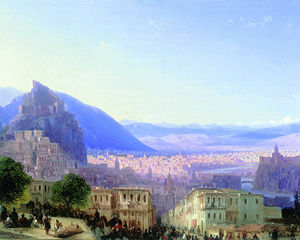 Tiflis by Ivan Aivazovsky
Tiflis by Ivan Aivazovsky
International relations
Twin towns and sister cities
Brother cities
Tbilisi has a brother city:[32]
Partnerships
See also
- Abo Tbileli, the patron saint of Tbilisi
- List of Famous Tbilisians
- Tbilisi International Airport
- Baku-Tbilisi-Ceyhan pipeline
- Georgia Tbilisi TV Broadcasting Tower
- Tbilisi Botanical Garden
Bibliography
- Georgian State (Soviet) Encyclopedia. 1983. Book 4. pp. 595–604.
- Minorsky, V., Tiflis in Encyclopaedia of Islam
- ICOMOS Heritage at Risk 2001/2002: Georgia, Tbilisi Historic District
References
Notations
- Giorgi Lomsadze (June 13, 2008). "In Tbilisi, a Battle Over Buildings Fires Investment Debate". Eurasianet.org. http://www.eurasianet.org/departments/insight/articles/eav061308.shtml.
- Tara Bahrampour (July 29, 2008). "Push to Rebuild Brings Protest in Georgia's Capital". The Washington Post. http://www.washingtonpost.com/wp-dyn/content/article/2008/07/28/AR2008072802867.html.
Footnotes
- ^ Pospelov, E.M. (1998). Geograficheskie nazvaniya mira. Moscow. p. 412.
- ^ "The Golden Age Of Georgia". Dictionary of Georgian National Biography. http://www.georgianbiography.com/history4.html. Retrieved 2008-02-02.
- ^ "Country Overview". Invest in Georgia. Archived from the original on 2008-01-01. http://web.archive.org/web/20080101022941/http://www.investingeorgia.info/georgia_profile/country_overview/. Retrieved 2008-02-02. "This early Georgian renaissance ... preceded its European analogue by several hundred years"
- ^ Ronald Grigor Suny (1994). The making of the Georgian nation. Indiana University Press. pp. 116–. ISBN 978-0-253-20915-3. http://books.google.com/books?id=riW0kKzat2sC&pg=PA116. Retrieved 16 November 2011.
- ^ Marshall, David (1962). History of Modern Georgia. p. 211.
- ^ Jones, Stephen F. (2005). Socialism in Georgian Colors. London.
- ^ Marshall, David (1962). History of Modern Georgia.
- ^ Rukhadze, Vasili; Tobias Moerschen (2007). "Analysis of Tbilisi's Real Estate Boom". http://www.nbg.gov.ge/uploads/workingpaper/nbgwp01.08.pdf. Retrieved 22 November 2009.
- ^ "Rustavi 2". Rustavi 2. http://www.rustavi2.com/news/news_text.php?id_news=39070&pg=1&im=main. Retrieved 2011-06-03.
- ^ Sergey Gevenov. "Tbilisi railway project to start : Story by Nino Edilashvili : Georgia Today on the Web". Georgiatoday.ge. http://www.georgiatoday.ge/article_details.php?id=7945. Retrieved 2011-06-03.
- ^ "Issue 1, 2010 - Tbilisi 2010". Investor.ge. http://www.investor.ge/issues/2010_1/10.htm. Retrieved 2011-06-03.
- ^ (Georgian) საქართველოს დედაქალაქის - თბილისის შესახებ. The Parliament of Georgia. Retrieved on May 22, 2007.
- ^ Karl Baedeker, Russia: A Handbook for Travelers (Arno Press, 1971, reprint of 1914 ed.), p. 467.
- ^ JSC IBERIA Realty Architectural Competition.
- ^ Pogoda.ru.net
- ^ "Climatological Information for Tbilisi, Georgia" - Hong Kong Observatory
- ^ a b c U.D. Anchabadze, N.G. Volkova (1990) (in Russian). Старый Тбилиси. Город и горожане в XIX веке [Old Tbilisi. City and city dwellers in the XIX century]. Moscow: Наука. ISBN 5-02-009979-1. http://books.google.com/books?id=XjkdAAAAMAAJ.
- ^ a b (Russian) Тифлис // Географическо-статистический словарь Российской империи. Сост. по поручению Русского географического общества действ. член Общества П. Семёнов, при содействии действ. члена В. Зверинского. St. Petersburg, 1885, p. 133.
- ^ (Russian) Первая всеобщая перепись населения Российской Империи 1897 г.. Распределение населения по родному языку и уездам Российской Империи кроме губерний Европейской России
- ^ (Russian)Первая всеобщая перепись населения Российской империи 1897 года. Изд. Центр. стат. комитета МВД / Под ред. А. Н. Тройницкого. 59: Тифлисская губерния. — St. Petersburg, 1905, pp. 74—75.
- ^ a b c d e (Russian) ETHNO-CAUCASUS, НАСЕЛЕНИЕ КАВКАЗА, РЕСПУБЛИКА ГРУЗИЯ, НАСЕЛЕНИЕ ГРУЗИИ
- ^ ETHNIC GROUPS BY MAJOR ADMINISTRATIVE-TERRITORIAL UNITS
- ^ "Subways and Trams In Georgia: Tbilisi". 2010-12-24. http://www.subways.net/georgia/tbilisi.htm. Retrieved 2010-12-24.
- ^ "georgiandaily.com - Nostalgic Tbilisi residents want their tramway back". 2010-12-24. http://georgiandaily.com/index.php?option=com_content&task=view&id=5011&Itemid=70. Retrieved 2010-12-24. "-"
- ^ "Railway Gazette: Tbilisi tram design contract signed". 2010-12-24. http://www.railwaygazette.com/nc/news/single-view/view/tbilisi-tram-design-contract-signed.html. Retrieved 2010-12-24.
- ^ "Trams to return? : by Salome Kobalava : Georgia Today on the Web". 2010-12-24. http://www.georgiatoday.ge/article_details.php?id=8365. Retrieved 2010-12-24.
- ^ "Head office." (direct image link) Georgian Airways. Retrieved on 6 October 2010.
- ^ a b c d e f g h i j k l m n "Tbilisi Municipal Portal - Sister Cities". © 2009 - Tbilisi City Hall. http://www.tbilisi.gov.ge/index.php?lang_id=ENG&sec_id=4571. Retrieved 2009-06-16.
- ^ "Yerevan Municipality - Sister Cities". © 2005-2009 www.yerevan.am. http://yerevan.am/main.php?lang=3&page_id=194. Retrieved 2009-06-22.
- ^ "Bristol City - Town twinning". © 2009 Bristol City Council. http://www.bristol.gov.uk/ccm/navigation/leisure-and-culture/tourism-and-travel/town-twinning/. Retrieved 2009-07-17.
- ^ "Ankara Metropolitan Municipality: Sister Cities of Ankara". © 2007 Ankara Büyükşehir Belediyesi - Tüm Hakları Saklıdır.Kullanım Koşulları & Gizlilik.. http://www.ankara-bel.gov.tr/AbbSayfalari/hizmet_birimleri/dis_dairesi_baskanligi/avrupa_gunu_kutlamasi.aspx. Retrieved 2008-12-08.
- ^ a b "TREND: Tbilisi, Vilnius become brother cities". en.trend.az. http://en.trend.az/news/cis/georgia/1492690.html. Retrieved 2009-10-12.
- ^ "Kraków otwarty na świat". www.krakow.pl. http://www.krakow.pl/otwarty_na_swiat/?LANG=UK&MENU=l&TYPE=ART&ART_ID=16. Retrieved 2009-07-19.
External links
- Official website of the City of Tbilisi
- Tbilisi city guide, includes daily events calendar
- DESIGNTbilisi
Coordinates: 41°43′N 44°47′E / 41.717°N 44.783°E

Cities and towns in Georgia Autonomous Republic of Abkhazia Sokhumi · Akhali Atoni · Gagra · Gali · Gudauta · Ochamchire · Tkvarcheli · Bichvinta · Gantiadi · Gulripshi · Leselidze · Miusera.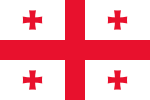
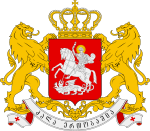
Autonomous Republic of Adjara Guria Imereti Kakheti Mtskheta-Mtianeti Samegrelo-Zemo Svaneti Samtskhe-Javakheti Akhaltsikhe · Akhalkalaki · Borjomi · Ninotsminda · Vale · Abastumani · Adigeni · Akhaldaba · Aspindza · Bakuriani · Bakurianis Andeziti · Tsagveriacha-Lechkhumi and Kvemo Svaneti Kvemo Kartli Shida Kartli Cities with local Government Capital City Tbilisi Administrative divisions of Georgia
Administrative divisions of Georgia 
Autonomous Republics 

Regions City with special status Tbilisi (capital)Categories:- Tbilisi
- Archaeological sites in Georgia (country)
- Capitals in Europe
- Holy cities
- Populated places along the Silk Road
- Populated places established in the 5th century
- Populated places in Georgia (country)
- Regions of Georgia (country)
Wikimedia Foundation. 2010.




